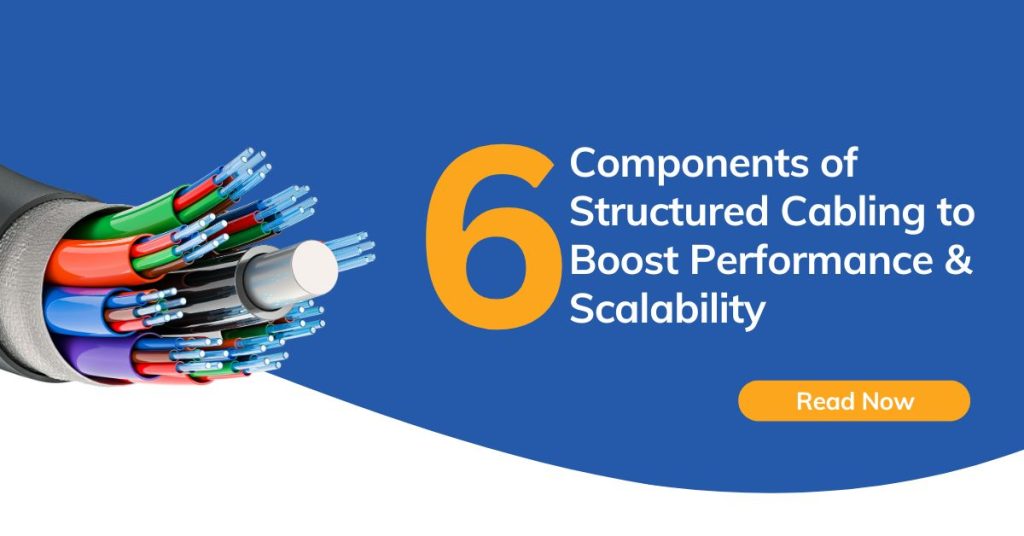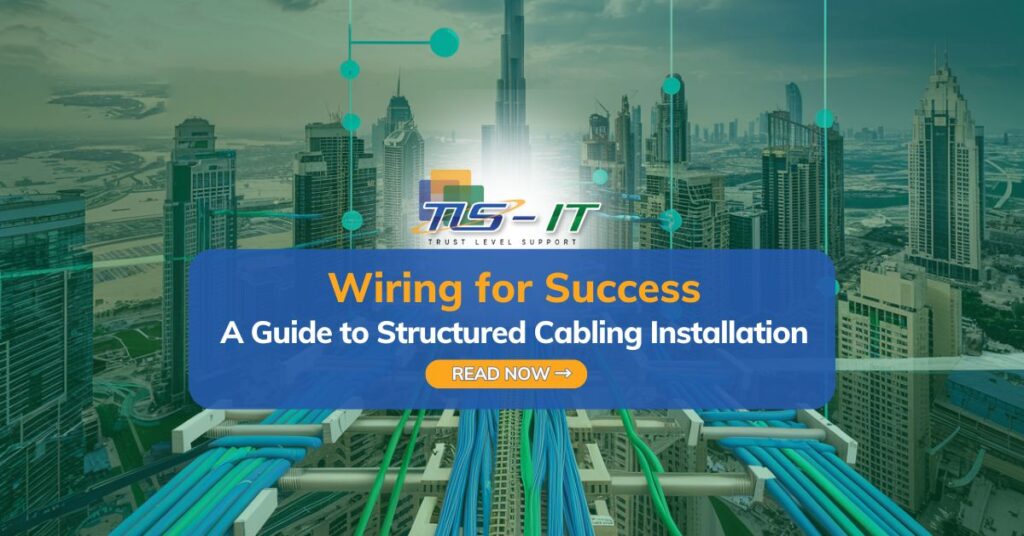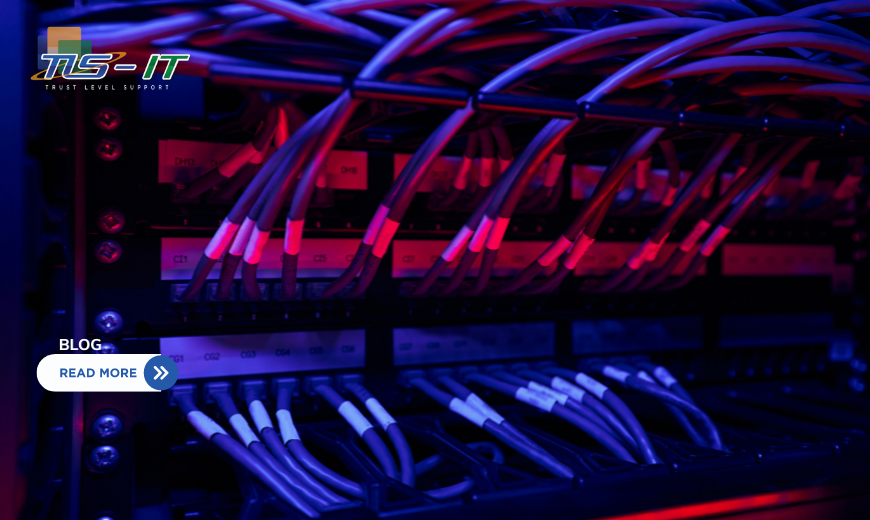A smooth and effective communication infrastructure is perhaps more important than ever in the quickly changing digital world of today. From businesses to educational institutions, healthcare facilities to entertainment venues, reliable connectivity forms the backbone of operations across various sectors. At the heart of this intricate web of communication lies structured cabling—a systematic approach to building and organizing a network’s physical infrastructure.
Structured cabling is not merely a set of wires and connectors; it’s a meticulously designed system that streamlines data, voice, and video transmission within buildings or campuses. Structured cabling improves the performance, scalability, and general efficiency of communication networks by using particular components and following established procedures.
We explore the six essential elements of structured cabling in this blog, which not only guarantee peak performance but also open the door to smooth scalability in response to changing technological requirements. From entrance facilities to work areas, each component plays a vital role in creating a robust and adaptable cabling infrastructure tailored to meet the demands of modern communication systems. Let’s explore how these components contribute to boosting performance and scalability in structured cabling networks.
What is Structured Cabling?
Structured cabling serves as the foundation for modern communication systems, providing a systematic and organized approach to building and campus cabling infrastructure. Unlike traditional methods, which handle each connectivity requirement individually, structured cabling offers a standardized framework designed to accommodate changes and expansions in hardware and connectivity needs.
What are the Standards of Structured Cabling in Dubai, UAE?
In Dubai, United Arab Emirates, structured cabling follows specific standards set by local regulatory bodies and organizations. The Emirates Authority for Standardization and Metrology (ESMA) and the Telecommunications Regulatory Authority (TRA) oversee standards compliance to ensure consistency and reliability across residential and commercial building cable distribution systems.
Benefits of Structured Cabling System
Adaptability:
A properly maintained structured cabling system provides unparalleled adaptability, allowing businesses to seamlessly adjust to new technologies, scale network speed or capacity, and relocate with ease. With a flexible infrastructure that can accommodate evolving needs, organizations can stay ahead of the curve and embrace emerging opportunities without being constrained by outdated infrastructure.
Risk Reduction:
The organized and standardized nature of structured cabling systems significantly reduces the risk of downtime associated with human error. By featuring clear labeling, documentation, and proper cable management, it minimizes errors during installations, maintenance, or upgrades, ensuring uninterrupted operations and maintaining productivity in Dubai’s competitive business environment.
Cost Efficiency:
Structured cabling systems offer long-term cost savings by reducing maintenance costs and downtime over time. With streamlined designs and scalability, businesses can minimize expenses associated with network repairs and upgrades, while the modular nature of structured cabling eliminates the need for wholesale replacements, providing a more cost-effective solution compared to traditional cabling systems.
Increased Productivity:
Reliable and efficient communication infrastructure directly contributes to increased productivity in the workplace. It ensures consistent network performance, minimal latency, and high data transfer speeds, enabling employees to access information, collaborate, and communicate seamlessly, thereby enhancing workflow efficiency and productivity in Dubai’s fast-paced business environment.
Simplified Management and Maintenance:
The organized and standardized nature of structured cabling simplifies the management and maintenance of network infrastructure. With clearly labeled cables, well-documented layouts, and standardized components, IT teams can quickly identify, trace, and resolve issues, reducing the time and effort required for maintenance tasks and allowing for remote monitoring and proactive management, which minimizes the risk of system failures and ensures optimal network uptime.
Future-Proofing:
Structured cabling systems are designed to accommodate future technological advancements and changes in business requirements. By adhering to industry standards and utilizing high-quality components, businesses in Dubai, UAE, can future-proof their communication infrastructure, ensuring compatibility with emerging technologies and scalability for future growth. Investing in structured cabling today provides businesses with the foundation they need to adapt and thrive in tomorrow’s digital landscape, positioning them for long-term success and innovation.
Why Structured Cabling is Important?
Structured cabling simplifies the installation of cable infrastructure supporting various voice and data communication equipment in Dubai’s bustling business landscape. By adhering to local standards, it enhances troubleshooting and maintenance while ensuring compatibility and ease of installation across diverse environments. Refer to the benefits to understand its vitality.
6 Components of Structured Cabling
Entrance Facilities (EF):
Act as the gateway for network service cables, providing points of interconnection between external and internal cabling, in accordance with ESMA and TRA regulations.
Entrance Facilities serve as the entry point for external network service cables into a building or campus. They include various elements such as the network demarcation point, backbone cabling interfaces, and telecommunications grounding infrastructure. EFs play a crucial role in facilitating the connection between external and internal cabling systems, ensuring efficient data transmission and network operation.
Equipment Room (ER):
The Equipment Room, also known as the Main Distribution Area (MDA), serves as the centralized hub for networking equipment within a building or campus. It houses essential hardware such as servers, switches, routers, and patch panels. The ER is designed to provide easy access to equipment for maintenance and upgrades while ensuring proper organization and protection of networking assets.
Backbone Cabling:
Backbone cabling, also referred to as vertical or riser cabling, forms the main infrastructure that connects Entrance Facilities, Equipment Rooms, and Telecommunications Rooms within a building or between buildings in a campus environment. It provides structural support and interconnectivity for data traffic, utilizing high-capacity cables and interconnects to ensure seamless communication between different parts of the network, adhering to ESMA and TRA guidelines.
Telecommunications Room (TR) and Telecommunications Enclosure (TE):
The Telecommunications Room (TR) or Telecommunications Enclosure (TE) serves as a central hub for network connections within a specific area or zone of a building. It facilitates the termination of horizontal cabling from work areas and the connection to backbone cabling. TRs/TEs house essential networking equipment such as patch panels, switches, and distribution racks, enabling efficient communication between various network components.
Horizontal Cabling:
It connects individual workstations, devices, and equipment to the network within a specific area or floor of a building. Horizontal cabling ensures device connectivity and flexibility, allowing users to access the network seamlessly. Itincludes cables, patch panels, outlets, and patch cords, all designed to provide reliable and high-performance connections for end-users.
Work Area (WA):
The Work Area is the endpoint where users interact with the network, connecting their devices to the structured cabling system. It includes outlets, patch cables, and devices such as computers, phones, and printers. The WA ensures user access, flexibility, and compatibility with various devices, contributing to a seamless and efficient network experience for end-users.
Understanding the six components of structured cabling is essential for designing, implementing, and maintaining a reliable and adaptable cabling infrastructure that meets the specific demands of Dubai’s business environment. By adhering to local standards and regulations, businesses can ensure optimal performance, flexibility, and scalability in their networks.
At TLS IT, we help businesses navigate the complexities of structured cabling in Dubai, ensuring they build robust and efficient communication systems compliant with ESMA and TRA standards. Contact us today to embrace the future of IT together.




